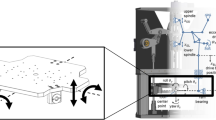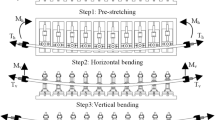Abstract
In this work a methodological scheme for a reduction of both the try-out and lead-time of complex dies is presented. The finite element simulation of the system press/tool behaviour along the stamping process results in criteria for the best design of high-cost dies/punches. Modifications of the main geometry, components and functional parameters are so recommended. Die deflection during the pressing process is in this work investigated. With the proposed methodology die manufacturers are able to avoid errors coming from die deformation due to their asymmetrical shape. At the same time, time of manual adjustment and polishing is reduced in a 30%. Examples are deeply explained as well as experimental evidences.
Similar content being viewed by others
References
Tekkaya A (2000) State-of-the-art of simulation of sheet metal forming. J Mater Process Technol 103:14–22
Balendra R, Qin Y, Lu X (2000) Analysis, evaluation and compensation of component-errors in the nett-forming of engineering components. J Mater Process Technol 106:204–211
Chodnikiewicz K, Balendra R (2000) The calibration of metal-forming presses. J Mater Process Technol 106:28–33
Cao J, Kinsey B, Yao H, Viswanathan V, Song N (2001) Next generation stamping dies-controllability and flexibility. Robot CIM-Int Manuf 17:49–56
Martínez F (2004) Optimisation du serre flan de son pilotage pour une amelioration de l’ecoulement du materiau en emboutissage, Ph.D., Université de Nantes, France
Rosochowski A (2001) Die compensation procedure to negate die deflection and component springback. J Mater Process Technol 115:187–191
Lingbeek R, Huétink J, Ohnimus S, Petzoldt M, Weiher J (2005) The development of a finite elements based springback compensation tool for sheet metal products. J Mater Process Technol 169:115–125
Thomas W, Oenoki T, Altan T (2000) Process simulation in stamping-recent applications for product and process design. J Mater Process Technol 98:232–243
Hernández A, Vallejo J, Canales J, Albizuri J (1999) Stamping die design based on numerical simulation and knowledge systematization. Int J Compute Integ M 12:427–438
López de Lacalle LN, Lamikiz A, Sánchez JA (2005) Improving the high-speed finishing of forming tools for advanced high-strength steels (AHSS). Int J Adv Manuf Technol 29:49–63
Ou H (2006) Prediction of dimensional errors in 3D complex shapes due to press elasticity. Int J Adv Manuf Technol 31:61–70
Chen FK, Liao YC (2002) An analysis of draw-wall wrinkling in a stamping die design. Int J Adv Manuf Technol 19:253–259
Tor SB, Britton GA, Zhang WY (2005) A knowledge-based blackboard framework for stamping process planning in progressive die design. Int J Adv Manuf Technol 26:774–783
Dequan Y, Rui Z, Jun Ch, Zhen Z (2006) Research of knowledge-based system for stamping process planning. Int J Adv Manuf Technol 29:663–669
Tang DB, Zheng L, Li ZZ (2001) An intelligent feature-based design for stamping system. Int J Adv Manuf Technol 18:193–200
Pilani R, Narasimhan K, Maiti SK, Singh UP, Date PP (2000) A hybrid intelligent systems approach for die design in sheet metal forming. Int J Adv Manuf Technol 16:370–375
Akatsu J (1991) Process for producing mold, EP 0 417 311. 20-3-1991
Del Pozo D, López JM (2002) Procedimiento de fabricación de troqueles, solicitud de PCT/ES02/00230, 14-5-2002
Del Pozo D, Rentería A (2003) Herramientas para la puesta a punto en la fabricación de troqueles. IMHE 285/286:139–142
Alzaga A, Yalniz Z (2003) Collaborative development of tools and dies in SMEs networks, CIRP Design seminar, Grenoble
López de Lacalle LN, Lamikiz A, Sánchez JA, Arana JL (2002) Improving the surface finish in high speed milling of stamping dies. J Mater Process Technol 123:292–302
Del Pozo D, López de Lacalle LN, López JM, Hernández A (2006) Machining of large dies based on the prediction of the press/die deformation, 2nd IPROMS Virtual International Conference on Intelligent Production Machines and Systems
Smith DA (2000) Die design hand book, 3rd edn. Society of Manufacturing Engineers, Michigan
Author information
Authors and Affiliations
Corresponding author
Rights and permissions
About this article
Cite this article
Del Pozo, D., López de Lacalle, L.N., López, J.M. et al. Prediction of press/die deformation for an accurate manufacturing of drawing dies. Int J Adv Manuf Technol 37, 649–656 (2008). https://doi.org/10.1007/s00170-007-1012-1
Received:
Accepted:
Published:
Issue Date:
DOI: https://doi.org/10.1007/s00170-007-1012-1




